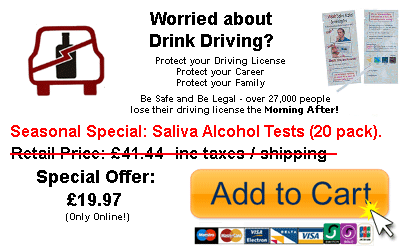
Drink Driving Limits for DUI / DWIInformation on blood / breath alcohol limits for DUI or DWI - Worldwide
…from your Partners in Patient
Care.
|
|||||||||||||||||
|
AUDIO: Click the Play buttons below to listen!
Healthcare Professionals
|
|
Drink driving, driving under the influence (DUI) or driving while intoxicated / driving while impaired (DWI) is a criminal offence in most countries due to the fact that alcohol and drugs can impair the user and make them a danger to other road users' safety when driving. Consequently, there are legal drink drive limits which motorists must abide by. The level of breath or blood alcohol which determines the legal limit varies depending on your own country's laws, but we have endeavoured to make a relatively comprehensive list below. (Scroll down to view). In addition, we have also put some USA specific information for each state, showing the legal drink drive limit, information on open alcoholic drink container laws for both drivers and passengers, information relating the possible suspension of your driving license and forfeiture of your vehicle. Of course, for anyone who wishes to be able to test themselves for alcohol to determine their blood or breath alcohol level, please visit our alcohol test kits page or our alcohol breathalyzers page. Our accurate on-site alcohol test kits for saliva, urine or breath) and digital breath alcohol tests are suitable for use in the workplace, by healthcare professionals or for home use. Many use them to measure against the legal drink drive limit in their country or state. In the UK and USA, this is 80mg/dl or 0.08% BAC (blood alcohol concentration). It should be understood however, that it can take from 25 to 40 minutes after drinking alcohol for the alcohol to have left your stomach and gone into your blood stream, so you should not assess your safety to drive immediately after drinking. Testing for safety to drive the morning after a night's drinking is a very good idea, as more than a quarter of people who lose their driving license for drink driving offences in the UK do so the morning after their drinking. Visit our drug information page, alcohol tests page or alcohol breathalyzers page for information on how long alcohol takes to leave the body. Before reading the legal drunk driving levels below, we hope that you appreciate that there is no "safe" level of alcohol if you intend to drive a motor vehicle. Alcohol affects co-ordination, judgement, reaction times and your ability to reason - including your tendency toward taking risks, so please exercise caution. It is advised that you allow a minimum of 1 hour per 1 unit of alcohol consumed before driving or operating heavy machinery or electrical equipment in order to ensure that you are not under the influence of alcohol. This simple formula will help: Number of units drunk - Number of
hours since last drink = Alcohol content For example: A person drinks 6 pints of an ordinary strength beer (12 units), finishing drinking at 11pm. They start work at 8am the following day. (9 Hours later). 12 Units - 9 hours = 3. In this scenario, the person could still have 3-4 units of alcohol left in their body whilst driving to work the following day - risking both Police prosecution and the safety of others. 3-4 Units will bring most men to the UK or USA legal driving limit of 80mg/dl and 3 units for most women. Please exercise caution. In the longer term, regular alcohol consumption increases your risks of: liver damage, cancer (of the liver, mouth, throat, and breast), mental health problems, weight gain, heart disease, stroke, shrunken genitals and reduced fertility. Alcohol reduces your body's ability to absorb nutrition, and the weight gain can also contribute to other conditions such as diabetes.
|
|
||||||||||||||
|
||||||||||||||||||||||||||||||||||||||||||||||||||||||||||||||||||||||||||||||||||||||||||||||||||||||||||||||||||||||||||||||||||||||||||||||||||||||||||||||||||||||||||||||||||||||||||||||||||||||||||||||||||||||||||||||||||||||||||||||||||||||||||||||||||||||||||||||||||||||||||||||||||||||||||||||||||||||||||||||||||||||||||||||||||||||||||||||||||||||||||||||||||||||||||||||||||||||||||||||||||||||||
|
|
© Drug-Aware Ltd 2002-2012. Unauthorised duplication or use of material from this web site is strictly prohibited. ALL RIGHTS RESERVED.
“Drug-Aware”, the Drug-Aware Logo and “Your Partners in Patient Care” are all Trade Marks of Drug-Aware Ltd.
Disclaimer - Whilst Drug-Aware Ltd has made every effort to ensure that all legal drink driving limits (DUI / DWI) information on this web site is current and accurate, we cannot be held responsible for any losses, damages, costs and other consequences resulting directly or indirectly from using this site and any information or material available from it. To the maximum extent permitted by law, Drug-Aware Ltd excludes all liability to any person arising directly or indirectly from using this site and any information or material available from it.
Sitemap NEW! Visit our Home Page for Technical Support and Articles on Drink, Drugs and Testing



